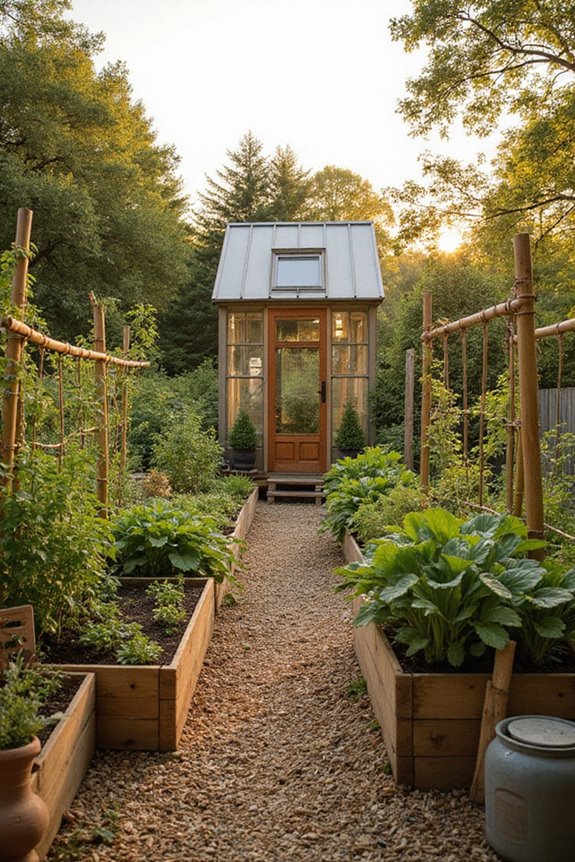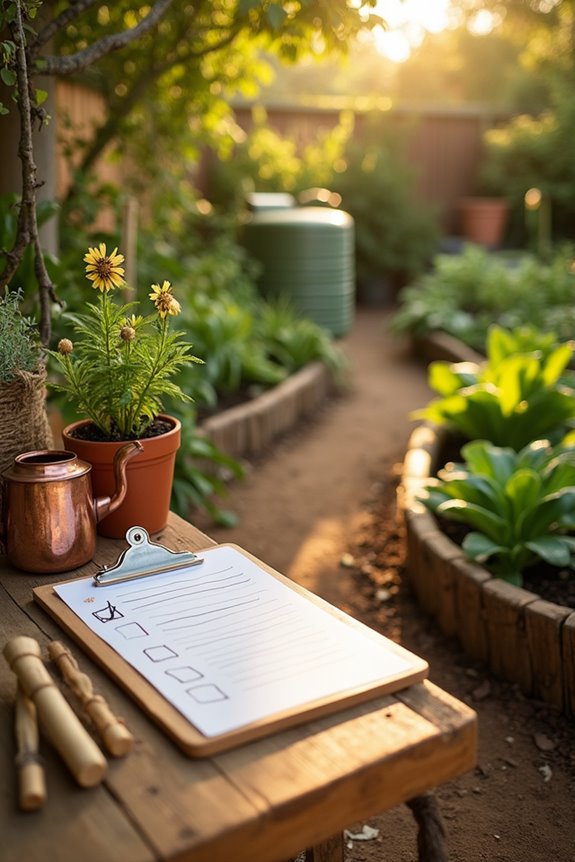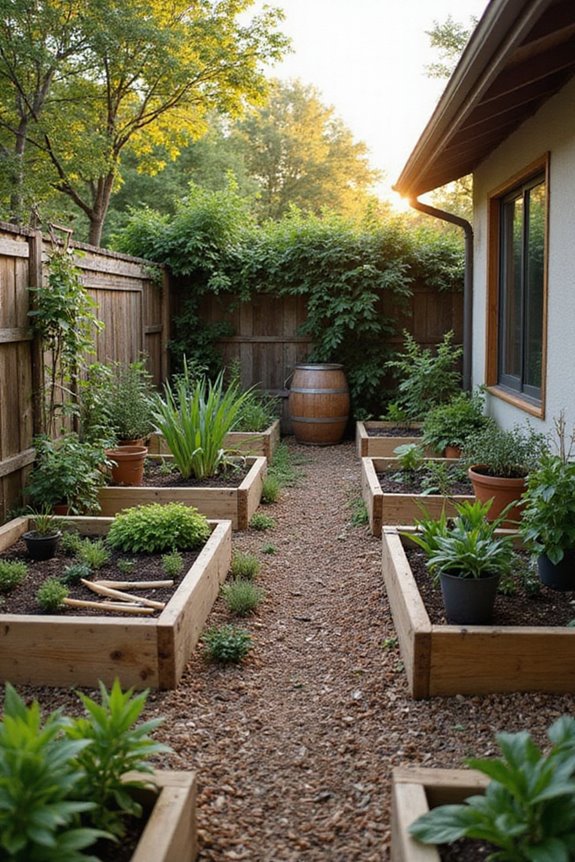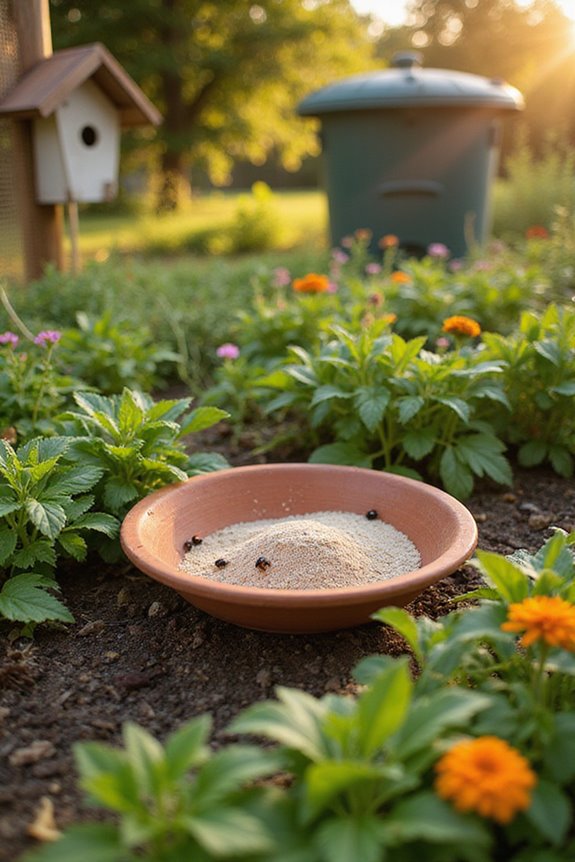We’re seeing exciting trends in sustainable gardening that prioritize the environment. More people are opting for wild planting and using native species to support local wildlife. Lawn alternatives, like clover and creeping thyme, save water and maintenance. Water management techniques, such as rainwater harvesting, are growing in popularity. Additionally, integrating edible plants into landscapes and participating in community gardens fosters biodiversity. With these changes, we can create gardens that benefit both ourselves and the planet. Discover more about these practices.
Key Takeaways
- Incorporating wildflower meadows and native habitats supports biodiversity while reducing maintenance and enhancing aesthetic appeal in gardens.
- Replacing traditional grass with drought-resistant groundcovers like clover and creeping thyme conserves water and supports local ecosystems.
- Implementing smart irrigation systems and rainwater harvesting promotes efficient water management and reduces reliance on municipal resources.
- Integrating edible plants into ornamental landscapes fosters biodiversity and food production, creating functional and beautiful garden spaces.
- Community involvement through gardens, workshops, and seed swaps strengthens local connections and promotes sustainable gardening practices.
Wild Planting and Naturalistic Landscapes
Wild planting and naturalistic landscapes are becoming popular for their relaxed and inviting aesthetics. Many of us are drawn to the beauty of wildflower meadows and native habitats. These gardens mimic nature’s charm, showcasing a mix of tall trees, shrubs, and groundcovers. We can create depth by layering plants, allowing them to flourish freely.
Incorporating native species reduces our gardening effort while supporting local wildlife. For instance, planting native grasses enhances biodiversity and offers food for pollinators. Using informal shapes and asymmetry reflects natural ecosystems, making our spaces feel lived-in. By embracing these principles, we foster a sense of belonging to nature, creating gardens that are not just beautiful but also beneficial to our environment.
Lawn Alternatives and Eco-Friendly Groundcovers
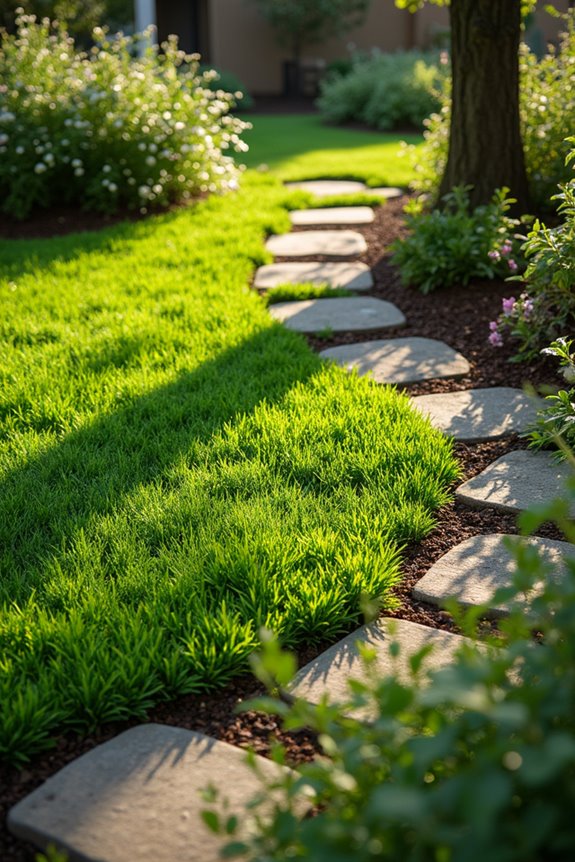
Lawn alternatives and eco-friendly groundcovers are gaining traction as more people seek sustainable gardening solutions. By embracing lawn reduction, we can replace traditional grass with durable options like clover, creeping thyme, and native violets. These native groundcovers not only require less water and maintenance but also support local biodiversity.
Incorporating nitrogen-fixing plants like white clover can naturally fertilize our soil. Using mulch or gravel as groundcovers can suppress weeds and improve drainage. These practical choices reduce our reliance on chemicals and enhance landscape aesthetics. Additionally, selecting native and drought-resistant plants can further contribute to water conservation efforts in landscaping.
Water Management and Permeable Landscapes
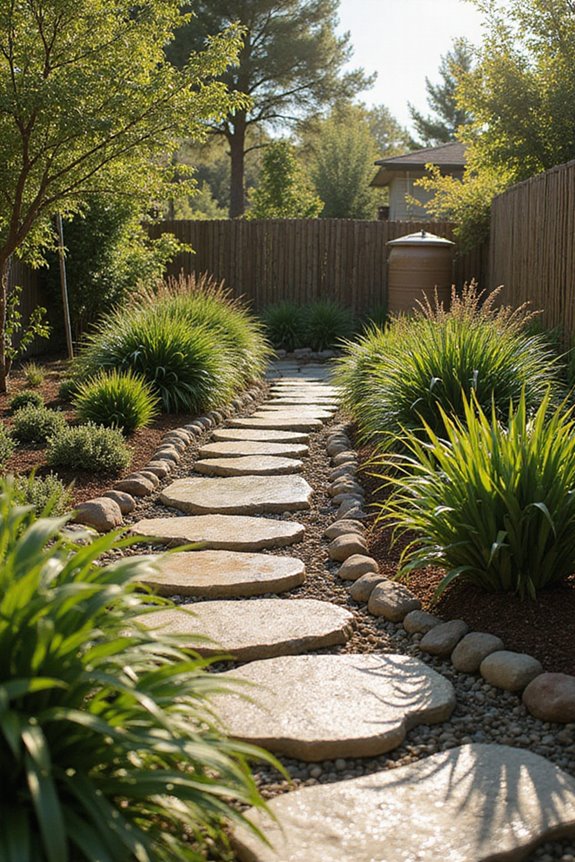
Water management is essential for sustainable gardening, especially as we face increasing climate challenges. One effective approach is smart irrigation, which uses adaptive scheduling and sensors to deliver precise watering. This reduces waste and helps us care for our plants efficiently. Technologies like Orbit B-Hyve and Rachio are great examples of smart irrigation systems.
We can also incorporate rainwater harvesting. By collecting rainwater from our roofs, we reduce reliance on municipal water. Storage tanks guarantee we have water available during dry spells.
Finally, using permeable surfaces in our landscapes allows stormwater to soak into the ground. This helps prevent flooding and supports healthier roots. Together, these practices promote a sustainable gardening future for our communities.
Edible and Functional Landscapes
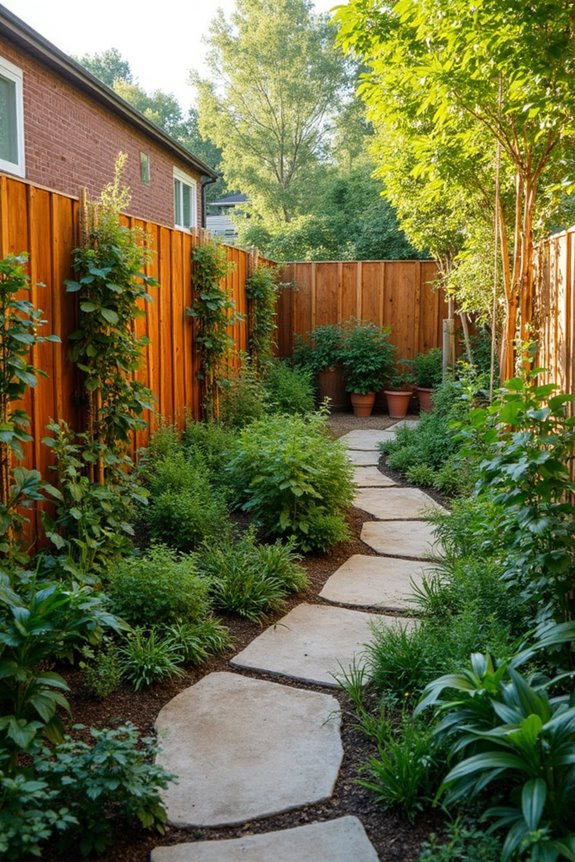
Creating edible and functional landscapes allows us to combine beauty with practicality in our gardens. By integrating edible plants like blueberry bushes and nasturtiums into ornamental beds, we achieve edible aesthetics while enhancing biodiversity. These multifunctional spaces convert traditional lawns into productive areas, boosting food security.
We can design our gardens to serve multiple purposes: food production, aesthetics, and outdoor living. For instance, placing climbing bean vines along patios not only looks great but also maximizes space. Additionally, incorporating drought-tolerant plants can further enhance the sustainability of our gardens by reducing water usage.
Using no-dig gardening techniques, we improve soil health without disturbing layers, ensuring sustainable growth. Overall, incorporating perennial edibles and native plants fosters resilience against pests and climate stressors, creating a thriving environment for us and local wildlife.
Living Fences and Green Boundaries
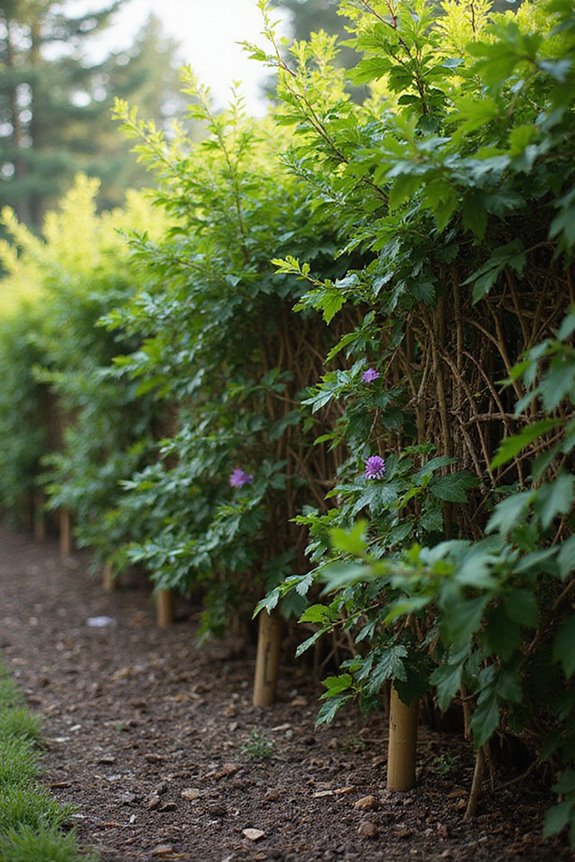
Living fences provide an innovative way to establish boundaries in our gardens while enhancing the environment. These green barriers offer numerous living fence benefits, such as promoting biodiversity by attracting pollinators like bees and butterflies. They also improve air quality and reduce urban heat by providing shade and cooling the surrounding air.
When designing a living fence, we can choose fast-growing species like privet or willow. Mixing evergreen and deciduous plants guarantees year-round privacy and seasonal interest. By integrating native plants, we support local wildlife and contribute to ecological design.
Mindful Gardening and Slow Gardening Practices
Mindful gardening and slow gardening practices invite us to slow down and truly appreciate the gardening experience. By focusing on mindful moments, we can engage more deeply with our surroundings. Instead of rushing for quick results, we can savor the texture of soil and the sounds of nature. This approach fosters a connection with nature and promotes inner peace.
Organic maintenance is at the heart of slow gardening. We can build soil health through compost and mulch, which also retain moisture. By using local resources and avoiding synthetic chemicals, we reduce our environmental impact. Embracing patience and allowing nature to take its course encourages biodiversity, creating a thriving ecosystem in our gardens. Additionally, focusing on native plants enhances local wildlife support and promotes a sustainable environment. Together, let’s enjoy this rewarding journey.
Supporting Pollinators and Biodiversity
Supporting pollinators and biodiversity is crucial for creating healthy ecosystems in our gardens. By integrating native flora, such as milkweeds and asters, we can attract important pollinators like bees and butterflies. These plants thrive with less water and care, making them ideal for sustainable gardening.
Creating pollinator corridors with these native species fosters habitats for birds and beneficial insects, promoting a balanced ecosystem. We can also support pollinators by designing habitats in small spaces and incorporating bee hotels.
Additionally, practices like “Leave the Leaves” and using staggered bloom plants guarantee pollinators have food and shelter year-round. By avoiding harmful pesticides, we protect these critical species and contribute to broader biodiversity in our environment. Including nectar-rich flowers in your garden can significantly enhance the attraction of butterflies and hummingbirds.
Urban Gardening and Community Involvement
Urban gardening is transforming how we connect with our communities and access fresh food. As we engage in community gardens, we can enhance our food security while enjoying the benefits of community involvement. Research shows that participants in these gardens double their intake of fruits and vegetables.
- Community Engagement: These spaces promote social interaction and cooperation, helping us forge stronger bonds with our neighbors.
- Gardening Education: Community gardens serve as educational hubs, teaching us sustainable gardening practices and food production skills.
Sustainable Tool Use and Material Choices
As we embrace community gardening, it’s important to contemplate how our tools and materials impact the environment. Using sustainable toolkits made from eco-friendly materials can greatly reduce our ecological footprint. For instance, tools with wooden handles sourced from sustainably managed forests are preferable to plastic alternatives.
We can also look for compact, multi-functional tools that reduce the number of items we need. Ergonomic designs help us garden longer without discomfort. Additionally, smart technology, like soil moisture sensors, conserves water and enhances our gardening efficiency. Investing in eco-friendly garden tools not only supports sustainable practices but also improves our overall gardening experience.
Frequently Asked Questions
How Can I Attract More Pollinators to My Garden?
Imagine our garden as a welcoming inn for winged guests. By adding nectar plants and pollinator hotels, we can create a vibrant oasis together, inviting bees and butterflies to thrive and share our green sanctuary.
What Are the Best Native Plants for My Region?
When considering the best native plants for our region, we should explore local flora that offers unique benefits. These plants not only enhance our gardens but also support wildlife and promote sustainable ecosystems in our community.
How Do I Start a Community Garden?
To start a community garden, we’ll focus on community involvement and thoughtful garden planning. Let’s gather neighbors, choose a sunny plot, and design a space where everyone can contribute, learn, and grow together.
What Tools Are Essential for Sustainable Gardening?
Like a well-tended garden, our sustainable tools shape our growth. We’ve found that essential gardening tools, from pruners to compost bins, unite us in nurturing our planet while cultivating a thriving, eco-friendly community.
How Can I Compost Effectively in Small Spaces?
To compost effectively in small spaces, we can use compact compost bins and explore worm composting. By doing this, we’ll not only reduce waste but also create nutrient-rich soil for our urban gardens together.

